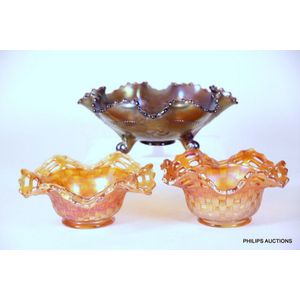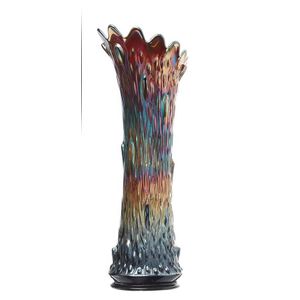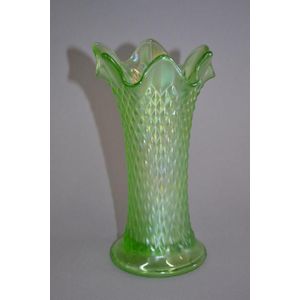
Northwood 'Peacock and Urn' Aqua Opal Carnival Glass Dish
Rare carnival glass dish, Northwood 'Peacock and Urn' aqua opal large bowl with ice blue vaseline glass, scalloped edge, diameter 24 cm

Collection of Ten Carnival Glass Items from Prominent Australian Collector
A group of ten carnival glass items, comprising a Northwood electric blue glass bowl in 'Peacocks on the Fence' pattern with ruffled edge, ribbed exterior and raised on a collar base, together with 9 other carnival glass items from the estate of a…

Northwood 'Hearths and Flowers' Plate and 9 Carnival Glass Items
A group of ten carnival glass items, comprising a Northwood marigold 'Hearths and Flowers' pattern plate (Purch. $2000 in 1997), together with 9 other carnival glass items from the estate of a prominent Australian collector. Height 4.5 cm, diameter 23 cm,…

Collection of Ten Carnival Glass Items from Australian Collector
A group of ten carnival glass items, comprising a Northwood 'Greek Key' pattern bowl in marigold with ruffled edge, together with 9 other carnival glass items from the estate of a prominent Australian collector. Height 8.5 cm, diameter 22.5 cm, and smaller

Collection of Ten Carnival Glass Items from Prominent Australian Collector
A group of ten carnival glass items, comprising a Northwood 'Three Fruit' stippled bowl in amethyst, with ruffled edge, basket weave exterior and on a collar base, together with 9 other carnival glass items from the estate of a prominent Australian…

Collection of Ten Carnival Glass Items from Australian Collector
A group of ten carnival glass items, comprising a Northwood 'Good Luck' pattern stippled bowl with pie crust edge in blue glass, together with 9 other carnival glass items from the estate of a prominent Australian collector. Height 8 cm, diameter 27 cm,…

Collection of Ten Carnival Glass Items from Australian Collector
A group of ten carnival glass items, comprising a Northwood 'Peacock at the Fountain' compote in amethyst / black, with ruffled edge, together with 9 other carnival glass items from the estate of a prominent Australian collector. Height 10 cm, diameter 20…

Amethyst Carnival Glass Wishbone Bowl (22 cm) on Feet
Amethyst Northwood carnival glass wishbone bowl on three feet, diameter 22 cm

Northwood's Stippled Rays Green Carnival Glass Bowl
Green carnival glass 'Stippled Rays' bowl by Northwood

Northwood's Embroid Mums Amethyst Carnival Glass Bowl
Amethyst carnival glass 'Embroid Mums' three foot bowl by Northwood

Northwood Marigold Carnival Glass "Good Luck" Shallow Dish
Marigold carnival glass 'Good Luck' shallow dish by Northwood

Northwood Sunflower Carnival Glass Bowl - 3ft
Iridescent carnival glass 'Sunflower' three foot bowl by Northwood

Green Raspberry Carnival Glass Tazza by Northwood
Green iridescent carnival glass 'Raspberry' tazza by Northwood

Green Iridescent Tree Trunk Carnival Glass Vase
Green iridescent carnival glass 'Tree Trunk' tall vase by Northwood

Carnival Glass Baskets and Wishbone Bowl Set
A pair of Fenton pressed Carnival glass baskets and a Northwood tripod Wishbone' bowl early 20th century, the marigold glass baskets with moulded decoration externally and pierced ruffled rims, and an olive amethyst floral decorated bowl with a ruffled…

Marigold Carnival Glass Trio
Three Marigold Carnival glass Wares: a 'Swung' vase by Fenton or Northwood, a two handled bowl and an oval dish, early 20th century, the tall 'Swung' vase with a typical asymmetric pulled rim and a ribbed decor; a pressed moulded goblet with textured and…

Carnival Glass Baskets and Wishbone Bowl Set
A pair of Fenton pressed Carnival glass baskets and a Northwood tripod 'Wishbone' bowl, early 20th century, the marigold glass baskets with moulded decoration externally and pierced ruffled rims, and; an olive amethyst floral decorated bowl with a ruffled…

Northwood Amethyst Carnival Glass Punchbowl 'Grape'
Northwood amethyst Carnival glass punchbowl, 'Grape', 27 cm high (including stand), 27 cm diameter

Northwood White/Ice Carnival Glass Bowl with Handles
Northwood white/ice Carnival glass bowl, two handles, 8 cm high

Set of 6 Northwood Singing Birds Carnival Glass Tumblers
Six Northwood green Carnival glass tumblers, 'Singing Birds', each 10 cm high

Northwood Blue Carnival Glass Peacock Butter Dish
Northwood blue Carnival glass lidded butter dish, 'Peacocks at the Fountain', 14 cm high (including lid)

Amethyst Carnival Glass Master Bowl with Stippled Rays
Northwood stippled rays amethyst carnival glass master bowl

Northwood Carnival Glass Amethyst Funeral Vase with Elephant Foot
A rare American Northwood Carnival glass 'Funeral' vase in amethyst with elephant foot, of elongated waisted form with wide frilled rim and typical textured surface, 49 cm high.

Large signed Northwood Carnival glass bowl
Northwood Carnival glass bowl signed to base 'N' approx 40 cm diameter

Northwood Twin Handled Footed Basket Bowl - 10cm x 16cm
Twin handled basket form Northwood footed bowl, approx 10 cm high, 16 cm long

Carnival and Milk Glass Comports and Dishes
Amethyst Carnival glass comport, green Northwood Carnival glass dish and a Victorian milk glass dish

Northwood Peacock & Urn Carnival Glass Dish - Aqua Opal
Rare Northwood peacock and urn Carnival glass dish with light iridescence between pastel and butterscotch in Aqua opal, 25 cm diameter


 Loading more...
Loading more...